Most biblical creationists today believe the behemoth, described in the book of Job, was a sauropod dinosaur of some sort. Sauropods bear an uncanny resemblance to the creature described in Job 40:15-24—a huge roaming herbivore with a tree-like tail. Here’s the passage.
Job 40:15 “Look now at the behemoth, which I made along with you; He eats grass like an ox. 16 See now, his strength is in his hips, And his power is in his stomach muscles. 17 He moves his tail like a cedar; The sinews of his thighs are tightly knit. 18 His bones are like beams of bronze, His ribs like bars of iron. 19 He is the first of the ways of God; Only He who made him can bring near His sword. 20 Surely the mountains yield food for him, And all the beasts of the field play there. 21 He lies under the lotus trees, In a covert of reeds and marsh. 22 The lotus trees cover him with their shade; The willows by the brook surround him. 23 Indeed the river may rage, Yet he is not disturbed; He is confident, though the Jordan gushes into his mouth, 24 Though he takes it in his eyes, Or one pierces his nose with a snare. (NKJV)
Not a modern creature
The description lists 3 attributes which, together, don’t seem to describe any known modern animal.
- He was extremely large (first of the ways of God; not disturbed by a raging river).
- He had a long tree-like tail (he moves his tail like a cedar).
- He was a roaming herbivore (eats grass like an ox; feeds on mountain vegetation).
Modern animals have some of these attributes, but none have all 3. Elephants and hippos are large herbivores, but have small twig-like tails. Crocodiles have large tree-like tails, but don’t eat grass, and definitely don’t frequent the mountains.
Sauropods had all of these attributes. They were large (the largest land animals ever discovered), roaming vegetarians with tails that could be described as trees.
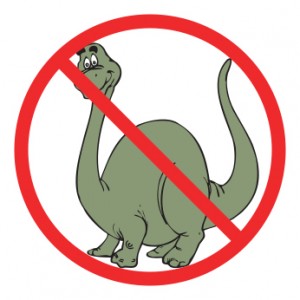 That said, many bible commentators reject this idea. Most have bought into evolutionary timelines which preclude the sauropod, supposing they went extinct before Job was written.
That said, many bible commentators reject this idea. Most have bought into evolutionary timelines which preclude the sauropod, supposing they went extinct before Job was written.
The arguments, however, don’t stop there. Many old earth advocates and skeptics go on to say that, even if sauropods were alive in Job’s day, they don’t fit the description. Sauropods were not semiaquatic, they didn’t eat grass, they couldn’t fit under lotus trees, their heads were too small, their feet were all wrong, etc., etc. They also accuse creationists of misinterpreting key passages like Job 40:17 which speaks of behemoth’s tree-like tail, and Job 40:19 which speaks of his supreme size.
In this article, we’ll take a look at some of these “incompatibilities.” Do the skeptics have a point? Have creationists overreached? Let’s take a look.
Behemoth can’t be a sauropod because…
Sauropods were not semiaquatic
A common argument is that sauropods are no longer considered semiaquatic as they once were. Early on, when first discovered, scientists speculated sauropods walked on the bottom of lakes to support their great weight. This is no longer the case. Scientists now categorized them as land animals. If the animal in Job was described as a water dweller, then, he obviously can’t be a sauropod. According to one skeptic,
Sauropods were once thought to be amphibious dinosaurs who spent nearly all of their lives in the water as depicted in the famous painting of Apatosaurus standing and feeding in the swamp created by Charles R. Knight a little over a century ago. People, many decades ago, didn’t think that sauropods were capable of walking on land because of their massive weight. So, they envisioned the sauropods as huge swampbound giants that spent nearly all of their lives in the water to lighten up their weight, ate water plants because of their weak teeth, and to be safe from meat-eating dinosaurs that could not swim. In the 1970’s, however, scientists began to learn that sauropods were not at all what people thought they were…… 1
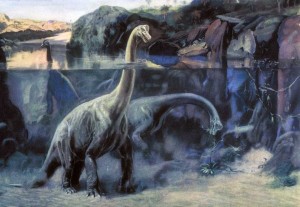 First, let me point out that virtually all creation scientists today agree that sauropods were not amphibious or semiaquatic. Many years ago, secular scientists believed they spent most of their lives in water, but this view has changed, and now, virtually all creation and secular scientists classify them as land animals.
First, let me point out that virtually all creation scientists today agree that sauropods were not amphibious or semiaquatic. Many years ago, secular scientists believed they spent most of their lives in water, but this view has changed, and now, virtually all creation and secular scientists classify them as land animals.
But, this all misses the point. The real question is, does the book of Job describe behemoth as semiaquatic? The answer is, no! It’s the skeptic who has overreached with the text in this case.
Yes, behemoth relaxed in shallow waters and waded through rivers, but this is the case with virtually all land animals. The text goes on to say that behemoth enjoyed mountain vegetation (40:20), suggesting he was a land roamer (just like sauropods). In fact, this was why the historical commentator Ellicott believed behemoth could not be a hippopotamus.
Then the difficulty is to make the description answer throughout to the hippopotamus (e.g., Job 40:20), since the hippopotamus does not frequent mountains,…
(Ellicott’s Commentary for English Readers).
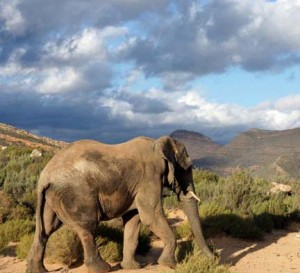 Before the discovery of dinosaurs, most commentators believed behemoth was an elephant, who is not considered semiaquatic. Obviously, historical commentators didn’t see the need to preclude the elephant, even though they viewed him as a land animal. Other historical interpretations of behemoth were the rhinoceros and water buffalo. Even in Jewish mythology, behemoth is an ox-like creature.2
Before the discovery of dinosaurs, most commentators believed behemoth was an elephant, who is not considered semiaquatic. Obviously, historical commentators didn’t see the need to preclude the elephant, even though they viewed him as a land animal. Other historical interpretations of behemoth were the rhinoceros and water buffalo. Even in Jewish mythology, behemoth is an ox-like creature.2
Behemoth is certainly described as comfortable in water. He relaxed in shallow waters (40:22) and he was able to wade through rivers (40:23), but this, as mentioned before, is characteristic of many large land animals. The semiaquatic objection fails.
Sauropods had the wrong kind of feet
The same skeptic goes on to say,
Unlike the hippo’s feet, the toes on the feet of sauropods are not splayed. Instead, the feet were all compact together like elephants and were supported by soft, squishy pads that gave the feet lots of support while walking on land. It would be useless to have them stand in a damp, muddy, swampy area, for their elephant-like feet, not suitable for walking on soft muddy terrain, along with their massive weight, would sink the sauropods into the mire and get them helplessly bogged down and stuck there.1
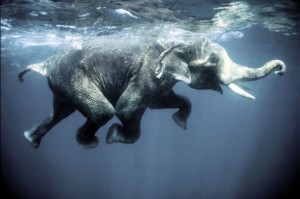 So, sauropods avoided water because they had elephant-like feet? Is he not aware elephants love water? Is he not aware that elephant feet do just fine walking in and out of water? In fact, elephant feet are quite efficient at propulsion in water making them adept distance swimmers. They are buoyant (as sauropods are believed to have been) and can swim for miles without tiring. This is not to say that sauropods could swim like elephants, but elephant-like feet pose no problem to the sauropod hypothesis. Elephants are the one animal today with feet that resemble sauropod feet, and just happen to love water.
So, sauropods avoided water because they had elephant-like feet? Is he not aware elephants love water? Is he not aware that elephant feet do just fine walking in and out of water? In fact, elephant feet are quite efficient at propulsion in water making them adept distance swimmers. They are buoyant (as sauropods are believed to have been) and can swim for miles without tiring. This is not to say that sauropods could swim like elephants, but elephant-like feet pose no problem to the sauropod hypothesis. Elephants are the one animal today with feet that resemble sauropod feet, and just happen to love water.
Sauropods would be crushed by water-pressure
 As mentioned earlier, old depictions of sauropods (based on old secular scientific understandings) showed them submerged at great depths walking on the bottom of lakes with only their heads protruding out of the water. This may not seem problematic to most, but when you consider the great height of these animals when holding their necks erect, it becomes very problematic. Unless they were specifically equipped by God to handle these depths, they could not withstand the pressure. But, creationists don’t dispute this, they point it out (see, for example, Sauropods: God’s Majestic Giants by AiG).
As mentioned earlier, old depictions of sauropods (based on old secular scientific understandings) showed them submerged at great depths walking on the bottom of lakes with only their heads protruding out of the water. This may not seem problematic to most, but when you consider the great height of these animals when holding their necks erect, it becomes very problematic. Unless they were specifically equipped by God to handle these depths, they could not withstand the pressure. But, creationists don’t dispute this, they point it out (see, for example, Sauropods: God’s Majestic Giants by AiG).
Furthermore, it’s completely irrelevant to this discussion, as there is nothing in Job suggesting behemoth walked completely submerged on lake bottoms. In fact, the text says specifically he liked to relax in shallow waters. “He lies under the lotus trees, In a covert of reeds and marsh…” (Job 40:12).
 Behemoth is also described as being able to wade through rivers, such as the Jordan, without becoming alarmed by a current surge. “Behold, if the river is turbulent he is not frightened; he is confident though Jordan rushes against his mouth…“ (Job 40:23). This also, however, has nothing to do with submerged, deep water walking. Virtually all large land animals cross rivers. The imagery, here, is not an animals submerged, but an animal head and shoulder deep holding his ground against a current.
Behemoth is also described as being able to wade through rivers, such as the Jordan, without becoming alarmed by a current surge. “Behold, if the river is turbulent he is not frightened; he is confident though Jordan rushes against his mouth…“ (Job 40:23). This also, however, has nothing to do with submerged, deep water walking. Virtually all large land animals cross rivers. The imagery, here, is not an animals submerged, but an animal head and shoulder deep holding his ground against a current.
Sauropods’ heads were too small
An old earth creationist comments,
First, while most of the passage could be attributed to a sauropod, verse 23, in which he “drinketh up a river”, does not sound like a sauropod. The New American Standard version states “If a river rages, he is not alarmed; He is confident, though the Jordan rushes to his mouth. Given the smallness of the sauropod’s mouth, this is an unlikely sight-picture.3
The objector here initially cited the KJV which speaks of behemoth poetically drinking up a river. But, he then cites a more likely translation found in the NASB which speaks of him being confident when the current rushes to his mouth. Another old earth advocate makes a similar objection.
For example, sauropod dinosaurs are characterized by their almost comically tiny-looking heads perched atop extremely long necks. Scientists say their heads were so small that they were probably among the least intelligent of dinosaurs. Yet, in Job, it describes the behemoth as having such a large head that, as the New American Standard Bible translates it, “If a river rages, he is not alarmed; He is confident, though the Jordan rushes to his mouth.” Sauropods, with their tiny mouths and long necks, would drink water in a way more like sucking water through a straw.4
He, in essence, argues that since sauropods had small heads and small mouths, they could not drink as much as a hippopotamus which had a much larger head and mouth. This, however, makes no sense as head and mouth size have nothing to do with consumption ability. The more accurate indicator is stomach capacity which definitely favors the sauropod. Hippos, amazingly, eat relatively light—only about 88 pounds (40 kilograms) of food a night,5 whereas large sauropods likely ate close to a ton of food per day. Which do you think drank more water?
But again, this all misses the point, as the text is not talking about literal drinking. Notice the difference between the KJV and other translations like the NASB.
Behold, he drinketh up a river, and hasteth not: he trusteth that he can draw up Jordan into his mouth. (KJV)
Job 40:23 If a river rages, he is not alarmed; He is confident, though the Jordan rushes to his mouth. (NASB)
Virtually all other translations render this similar to the NASB, which speaks about the Jordan rushing to his mouth. I believe the ESV captures the idea best speaking of the river flowing against his mouth.
Behold, if the river is turbulent he is not frightened; he is confident though Jordan rushes against his mouth. (ESV)
The passage isn’t speaking of drinking, but rather of the current of the Jordan rushing against his face (poetically, his mouth, the first contact point of the face). What these objectors fail to realize is that a small head attached to a long tapered neck would be an advantage facing a current, making the animal streamlined. Take a look at the body of diplodocus (a sauropod dinosaur) from the top view.
They were giant javelins! The objector might also have been confused about the angle most sauropods held their necks. Unlike brachiosaurs who held their necks vertically like giraffes, most sauropods held their necks horizontally. Thus, they did not need not be completely submerged for the water to rush against their faces (mouths).
 What I see here is a body shape that would cut through a current quite efficiently, making him”…confident though Jordan rushes against his mouth.”
What I see here is a body shape that would cut through a current quite efficiently, making him”…confident though Jordan rushes against his mouth.”
Sauropods were too buoyant
Skeptics also speculate sauropods like diplodocus were extremely buoyant and may have been unstable swimmers. Keep in mind, elephants are buoyant and great swimmers, but let’s grant the premise. It’s very possible sauropods were poor swimmers.
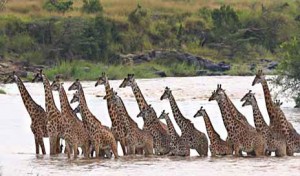 This, again, is totally irrelevant. The idea of behemoth swimming is never brought up in Job. All we’re told is that he could wade in rivers even when they surged and stand his ground. Even giraffes, who are suspect swimmers, have been seen crossing rivers. It would stand to reason that the larger and heavier the animal, the stronger current they can handle. What should we expect, then, of the largest land animal God ever made?4
This, again, is totally irrelevant. The idea of behemoth swimming is never brought up in Job. All we’re told is that he could wade in rivers even when they surged and stand his ground. Even giraffes, who are suspect swimmers, have been seen crossing rivers. It would stand to reason that the larger and heavier the animal, the stronger current they can handle. What should we expect, then, of the largest land animal God ever made?4
Sauropods could not eat grass
A skeptic explains,
According to the passage, Behemoth is said to eat grass like an ox. Although, nowadays, it is known that some sauropods like Diplodocus have horizontal necks that can easily reach the ground for ferns to eat, sauropods, unlike cows, completely lack chewing teeth (e.g., molars). Sauropods were wholly incapable of chewing their food at all.1
 The first thing that came to my mind, hearing this objection, was dogs. Has he never witnessed a dog eating grass? Dogs certainly don’t have typical herbivore chewing teeth, yet feast on grass often.
The first thing that came to my mind, hearing this objection, was dogs. Has he never witnessed a dog eating grass? Dogs certainly don’t have typical herbivore chewing teeth, yet feast on grass often.
Now, he is certainly correct that sauropods ate other foods, but if we look at the text, so did behemoth. Along with grass he is said to have feasted on mountain vegetation (40:20). Perhaps he’s correct that sauropods did not chew grass like oxen, but neither do dogs. They just pull it out of the ground and swallow it.
If carnivorous dogs can supplement their diet with grass, how can someone conclude just from fossilized teeth that a pure herbivore like diplodocus never ate grass? —especially, after admitting they held their head and necks horizontally and could have grazed the ground if they chose?
The text itself does not require behemoth to chew or digest grass like an ox. Nor, does it require grass to be his main staple. It merely says he ate grass like an ox. If a dog can do it, so can a sauropod.
All that said, we now have fossilized evidence that sauropods ate grass. According to LiveScience.com, “Dung Reveals Dinosaurs Ate Grass.”
Until now there was no firm evidence that dinosaurs and grasses coexisted, so scientists assumed that herbivorous dinosaurs ate mostly trees, ferns, flowering plants and cycads.
The droppings most likely came from titanosaur sauropods which weighed more than 100 tons and were the heaviest creatures to ever walk the Earth. Although scientists knew from the shape of their teeth that titanosaurs were plant eaters, this is the first proof that dinosaurs snacked on grass.
Case closed!
Sauropods were too large to fit under lotus plants
An old earth creationist writes,
The second problem with the sauropod interpretation is verse 21. The KJV is good, but a more literal translation is better here. The NASB says, “Under the lotus plants he lies down, The willows (reeds) of the brook surround him.” It is difficult to imagine the Argentinosaurus, at 100 feet long, and a height of 70 feet when standing (sitting, probably 20 feet tall), resting under the short limbs of a lotus plant (or tree), nor would he be able to take cover in reeds only a few feet tall.3
First, the exact meaning of the lotus, here, is unclear, as it is not mentioned anywhere else in the Old Testament. Greek mythology references a lotus tree, but its exact identity is unknown (Eerdmans Dictionary). Willow trees are mentioned in parallel, which were known to grow along river banks. Perhaps, the lotus tree referenced here was a similar tree.
I find it interesting, though, regardless of the exact tree species, that the objector misses the importance of behemoth lying down (thought he did mention it). Yes, sauropods could be an astounding 70-100 ft tall when standing with their necks erect, but so what? The passage does not speak of standing animal.
Job 40:21 He lies under the lotus trees, In a covert of reeds and marsh. 22 The lotus trees cover him with their shade; The willows by the brook surround him.
All that is required to shade the largest of sauropods6 lying down is a 20-30 foot tree. The argument fails.
And behemoth’s tail wasn’t really like a tree, because…
The text is only describing the motion of a tree
An old earth creationist writes,
Strict creationists often emphasize verse 17, since sauropods have very large tails, whereas hippos and elephants have relatively small tails. However, the passage does not say that the tail was like a cedar tree in size, only in movement. The verse need not even refer to the swaying motion of a tree trunk, but could refer to that of a cedar branch or switch.7
When I heard this objection, my first response was, huh? Behemoth’s tail is like a tree “only in regard to movement”? What exactly does that mean, and how so elephant or hippo tails mimic tree movement? If you’re drawing a blank, you’re not alone.
Now, it is true that a tree could serve as a simile for something other than shape or size. For instance, I could describe someone standing still like a tree and it would have nothing to do with size. I could describe a small child in this way: “Johnny stood still like a tree.” That’s because this action (or lack thereof) is a well known characteristic of trees. But, moving like a tree is a non-starter. One can move like a cat, or a snail, conversely, but moving like a tree? It has to be a reference to size.
To draw an analogy, if I spoke of an object “moving like a mountain through space,” what would you infer? Would you think of the movement of mountains? Or would you think of a large mountain-sized object moving through space, such as a asteroid? If movement is not a general characteristic of the object, then it’s not what the metaphor is communicating.
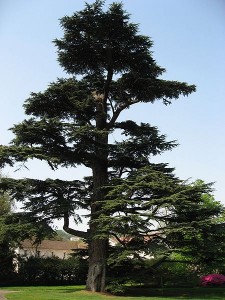 Case in point, Cedar trees are known for their size. According to Eerdman’s Dictionary,
Case in point, Cedar trees are known for their size. According to Eerdman’s Dictionary,
Cedars of Lebanon grow up to 28 m. (90 ft.) tall and may live 3000 years. Many more cedar forests were in Lebanon in biblical times than exist there today. The wood of the tree was a popular commodity used in building. It carries a pleasant fragrance and resists insects. The Bible records several instances of cedars of Lebanon used in construction, the best known being Solomon’s temple……
Note, also, they are commonly used as metaphors in the Old Testament, almost exclusively, for size and strength. Eerdman’s Dictionary continues,
….The Bible also contains many references to the great height and strength of cedar trees. Amos prophesies that the might of the Amorites “was like the height of cedars” (Amos 2:9), and Ezekiel compares Assyria’s power to a cedar of Lebanon (Ezek. 31:3-9). The psalmist compares the growth of the righteous to that of the cedars of Lebanon (Ps. 92:12[MT 13]), and Zechariah uses the image of destroyed and fallen cedars and other trees to show how devastating God’s judgment will be (Zech. 11:1-2)….
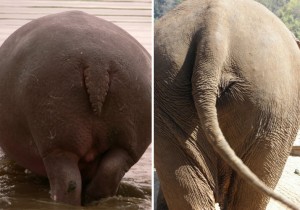 Yet, this skeptic believes they’re a metaphor for small rope-like elephant tails, or tiny flap-like hippo tails. It boggles the mind what some are willing to believe. For those willing to read the text with an open mind, however, it’s not difficult to understand what God is saying. Behemoth moved and swayed his tree-like tail.
Yet, this skeptic believes they’re a metaphor for small rope-like elephant tails, or tiny flap-like hippo tails. It boggles the mind what some are willing to believe. For those willing to read the text with an open mind, however, it’s not difficult to understand what God is saying. Behemoth moved and swayed his tree-like tail.
The text is only describing a tree branch
This same old earth advocate goes on to say,
Indeed, Michael Bright suggests that the description may refer to bristles resembling the cedar’s needle-like leaves which are present on the tails of elephants and hippopotami.7
This would be a very odd way to describe a cedar branch, if this is indeed what was intended. In other biblical poetry, cedar branches are spoken of as distinct properties of cedars.
Psa. 80:10 The mountains were covered with its shade, the mighty cedars with its branches. (underline mine)
Ezek. 17:23 On the mountain height of Israel will I plant it, that it may bear branches and produce fruit and become a noble cedar. And under it will dwell every kind of bird; in the shade of its branches birds of every sort will nest. (underline mine)
Ezek. 31:3 Behold, Assyria was a cedar in Lebanon, with beautiful branches and forest shade, band of towering height, its top among the clouds. (underline mine)
Notice the reference to the “towering height” of cedars, and notice the branches are referenced separately as “its branches” or “with branches.” There is also a reference to cedars in Eden in Ezekiel, speaking distinctly of its branches.
Ezek. 31:8 The cedars in the garden of God could not rival it, nor could the junipers equal its boughs, nor could the plane trees compare with its branches— no tree in the garden of God could match its beauty. (underline mine)
Furthermore, the movement of branches (perhaps blowing in the wind) in no way resemble the movements of elephant or hippo tails. The simple conclusion is that the cedar metaphor in Job is not referring to a branch. If it were, God would have said so.
Tail really means genitalia?
Finally, we get to the most creative objection of all. Tail doesn’t actually mean tail. The text is rather referring to an elephant’s trunk, or—get this—his genitalia.
Since the Hebrew term usually translated “tail” here can also refer to any appendage on an animal other than a limb, it may also refer to the motion of a different kind of trunk–namely that of an elephant. Scholars also note that the Hebrew term usually translated “tail” here can, and sometimes did, refer euphemistically to the genitalia of a male elephant or hippo; each have a penis that when erect, extends several feet in length. Those favoring this view note that the term for “move” can also mean “extend,” that the preceding verse describes strength being in the loins, and the verse that follows describes “stones wrapped in sinew,” which arguably refers to the animal’s testicles….7
The word for tail in verse 17 is zanav in the original text. It is used several times in the Old Testament, and when referring to an animal, always refers to a literal tail (tails of snakes-Ex. 4:4, tails of foxes-Judg. 15:4). Tail is the primary meaning of this word, and it is never used in the Bible to describe any other animal appendage. Furthermore, when zanav is used metaphorically in the Old Testament, it always describes the tail end of something or something that is last in line or last in rank, very similar to how the english term might be used.
With that in mind, think about the two possibilities suggested by this old earth skeptic. An elephant’s trunk is located in the front of an elephant, not the tail end. Also note that behemoth’s nose (‘aph) is mentioned in verse 24. “Can one take him by his eyes, or pierce his nose with a snare?” If an animal has a trunk, he would not have a nose also.
But, could this passage be speaking of elephant or hippo genitalia? Now, in all languages, words can be used to mean virtually anything in the right context. I have no doubt that in Hebrew, at some time in history, tail was used in a non-literal way, perhaps even like this. But context will aways make this clear. Does this passage contain such a context? Most skeptics will turn to the King James which speaks about behemoth’s navel and stones which they see as references to reproductivity.
Job 40:16 Lo now, his strength is in his loins, and his force is in the navel of his belly. 17 He moveth his tail like a cedar: the sinews of his stones are wrapped together.
The problem is, he is cherry picking one translation and ignoring virtually every other translation in existence, including the New King James and YLT which utilize the same manuscripts. Notice the absence of the terms “navel” and “stones” in these translations.
Job 40: 16 See now, his strength is in his hips, And his power is in his stomach muscles. 17 He moves his tail like a cedar; The sinews of his thighs are tightly knit. (NKJV)
Job 40:16 Lo, I pray thee, his power [is] in his loins, And his strength in the muscles of his belly.
17 He doth bend his tail as a cedar, The sinews of his thighs are wrapped together, (YLT)
The word translated navel in the KJV is shariyr, which conveys the idea of hardness, and, interestingly, it’s in the plural. If it really meant navel, it should properly be translated “navels” which would be quite odd as there is no known animal with multiple navels. The vast majority of translations rather see this hardness as the stomach muscles, and translate it muscles, in the plural, which corresponds to the context of the size and strength. The word for stones here is pachad which means thigh (KM Hebrew Dictionary, BDB), and is translated thigh in virtually all English translations.
The passage is merely speaking of the animal’s stomach muscles and the tendons of its thighs which likely bulged out when he walked upholding his enormous weight. This fits the context which is why translators favor it.
Some believe the verb in verse 17 should be rendered “stiffens his tail” rather than “moves his tail,” but this, too, would help the sauropod hypothesis. Jonathan Sarfati points out,
…modern paleontologists now believe that dinosaur tails were held quite rigidly horizontal, not dragging on the ground as in some of the older illustrations. This fits very well with the simile of a big tree trunk.8
Sauropods actually could stiffen their tails, unlike hippos and elephants.
And Behemoth wasn’t really the largest land animal, because…
“first of the ways of God” doesn’t necessarily mean biggest
In Job, we read,
Job 40:19 “He is the first of the works of God; let him who made him bring near his sword!
Skeptics who favor the hippopotamus interpretation of behemoth point out that, in of itself, “first of the ways of God” is a phrase that simply refers to something first in rank among God’s works or creatures. It is not specifically a reference to size. Hippos, even today, are not the largest land beasts, but don’t need to be to fit the behemoth description (so they argue).
The skeptics are right on this specific point, as the Hebrew word for first, is re’shiyth, the same word used for “beginning” in Genesis 1:1. The word is often used in reference to rankings in the Old Testament—the choicest produce (Ex. 23:19, 34:26) or the choicest land (Deut. 33:21) or the most powerful nations (Num. 24:20, Amos 6:1). It is not exclusively a reference to size or strength. Only context can determine the specific rank intended.
What then is the context of this passage? Is it not all about behemoth’s great size and strength? Yes, “first of the ways of God,” in and of itself, can have multiple meanings, but the context of the Job 40 is pretty straightforward. The behemoth was the largest of the large and strongest of the strong. He was first among the large and powerful creatures of God.
Conclusion
Having weighed all the objections, I’ve come to the conclusion the sauropod dinosaur is still the best candidate for behemoth. It’s not the creationists, but, rather the objectors who have gone beyond what is written (1Cor. 4:6). Their bias toward evolutionary timelines has caused them to read incompatibilities into the text which aren’t there.
Behemoth was a roaming land animal who fed on mountain vegetation and grass. He enjoyed shallow waters and could wade through strong currents without fear of being swept away. He was first in size and strength among God’s land creatures. He had a massive tail which resembled a cedar. There is only one known animal that fits these descriptions. Evolutionists don’t believe he shared the planet with men, but the biblical record states otherwise. “Behold behemoth whom I made with thee.” God created all land animals with man on day 6. If we choose to believe biblical history, the sauropod explanation is best.
Does it matter?
Do positions in this area have any real impact on theology or the church? Do they impact evangelism, or the Christian walk? I think they possibly can, yes. We have to be very careful, but, at the same time, we have to ponder the presuppositions that influence our approach to Scripture. It’s one thing to examine certain passages and come to different conclusions, it’s another to impose man’s fallible theories (such as evolutionary timelines) onto the text. If we reject the most obvious reading of a passage because it challenges man’s ideas, we’ve missed out. We need to test men’s theories by Scripture, rather than testing Scripture by man’s theories.
Many Christian scholars reject the sauropod explanation out of hand, based on their acceptance of millions of years. They will never see a sauropod in Job because their presuppositions preclude it. Henry Morris put it,
“Modern Bible scholars, for the most part, have become so conditioned to think in terms of the long ages of evolutionary geology that it never occurs to them that mankind once lived in the same world with the great animals that are now found only as fossils”9
This ought not be the case.
Recommended Video
Does the Bible (Job 40) Describe a Sauropod Dinosaur (Behemoth)?
Further Reading
Regarding mythological interpretations of behemoth and leviathan:
Behemoth and Leviathan–Creatures of Controversy
by Eric Lyons, M.Min. (Apologetics Press)
Behemoth and Leviathan: Figurative or Literal? (Part 1)
by Dave Miller, Ph.D. (Apologetics Press)
Behemoth and Leviathan: Figurative or Literal? (Part 2)
by Dave Miller, Ph.D. (Apologetics Press)
Regarding dinosaurs existing only thousands of years ago:
Dinosaur soft tissue: In seeming desperation, evolutionists turn to iron to preserve the idea of millions of years.
by Calvin Smith (CMI)
Dragons in History and Ancient Dinosaur Depictions
(Genesis Park)
Regarding behemoth and leviathan being real animals:
Behemoth and leviathan in the book of Job
by Mart-Jan Paul (CMI)
Footnotes
1. EvoWiki, “The Truth About Behemoth” (http://evolutionwiki.org/wiki/The_Truth_About_Behemoth)
2. About Religion: Judaism, “What Is the Behemoth? The Behemoth in Jewish Mythology” (http://judaism.about.com/od/jewishhistory/a/What-Is-The-Behemoth.htm)
3. Old Earth Ministries, “Job 40-41: Dinosaurs in the Bible?” (http://www.oldearth.org/job4041a.htm)
4. theTrumpet.com, “What Is the Behemoth?” (https://www.thetrumpet.com/article/8533.20.137.0/science/what-is-the-behemoth)
5. San Diego Zoo Animals, “Mammals/Hippo” (http://animals.sandiegozoo.org/animals/hippo)
6. While it’s possible that the sauropods in Job’s day were 100 feet tall, it’s likely they were smaller as animals later in history, after the flood, become smaller than their ancestors. We see this in several kinds of animals including many reptiles. Sauropods would have still been the larges land animals of the time, but the particular behemoth God was showing Job did not need to be the largest sauropod that ever existed.
7. Glen J. Kuban, “Does the Bible Describe Dinosaurs in Job 40 and 41?” The Paluxy Dinosaur/Man Track Controversy, 2008 (http://paleo.cc/paluxy/behemoth.htm)
8. Jonathan D. Sarfati “The Genesis Account: A theological, historical, and scientific commentary on Genesis 1-11” (Creation Book Publishers, Powder Springs, GA 2015)
9. Henry M. Morris, “The Genesis Record” (Creation-Life., San Deigo, CA, 1976)

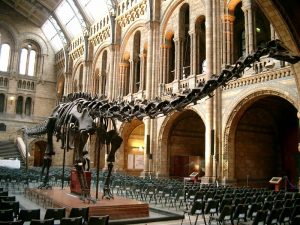

And don’t forget about Job 41,11. they breath with fire becouse of metabolism. as we know temperature of animal body depends among others on capacity of body. becouse body produces heat and body it means capacity. and ability of body to exchange heat with neighbours environment depends among others on surface of body becouse body can exchange heat through skin. And in case of small animal ratio between surface and capacity is such that the problem is how to stay warm and don’t be freezing so small animal eats often to keep metabolism on high level and wears fur, hair to prevent skin from getting easly cold. and by the way nose is constructed in such a way that it exchange air slowly to prevent loosing heat. and case of BIG animal is opposite. ratio between surface and capacity is such that the problem is how to quickly loose heat and get much cooler temperature. so skin of elephant has no fur. and now think about dino for example 70tons capacity there is fire inside! so Daniel or polish hero Skuba in Krakow could easly kill dragon by feeding them with combustible material. and it cause of dead was flame or to much water drinking. But look almost in every culture people know that dragon breath give fire (in Job in China) so it means that they have seen dragons alive! and more over scientists exsmined nose bones of sauropod and they came to conclusion that sauropod’s noses are build to exchange air as quickly as possible noses are bild to loose heat not to keep it inside. and we know why – becouse of almost burnig metabolism.
Hey, I really appreciate you writing this article. I’m a christian. At first I believed in theistic evolution, but when I did more research through the lens of the Bible, I become a creationist. Now when people try to claim Behemoth was not a sauropod, I can defend my faith. Thanks!
Thank you for reading and reaching out. That’s why I wrote it. Some of the arguments against the sauropod theory seemed off (and frankly, extremely biased), and they drove me to research and study the issue further. Writing this article was a blessing to me, and I’m so glad it was helpful to you.
I agree with the Sauropod theory. There is no animal other than a Sauropod that fits the description. Which species it is could be debated but it is a Sauropod dinosaur.
Yeah, after a lot of research, I can’t think of another creature that fits the Text. Behemoth was a plant-eating land animal (not semi-aquatic), with a long tree-like tail, that could wade across flooding rivers and travel to the mountains to graze. That eliminates hippos, elephants, crocs, rhinos, and even the Paraceratherium. I suspect it was a sauropod that held its neck low, parallel to the ground, like the Diplodocus. I could see them with their heads low at water level, cutting through the water as they walked up the river. Can’t be totally dogmatic. Sure wish I could travel back to that time and witness it myself!